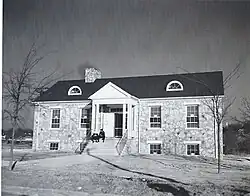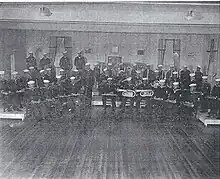| Hargraves Community Center | |
|---|---|
 Hargraves Center c. 1942 | |
| Former names |
|
| General information | |
| Address | 216 North Roberson St, Chapel Hill, NC |
| Coordinates | 35°54′46.368″N 79°3′49.824″W / 35.91288000°N 79.06384000°W |
The Hargraves Community Center is located at 216 North Roberson Street in Chapel Hill, North Carolina.[1] Originally known as the Negro Community Center, it was renamed in 1973 after William M. Hargraves, a former member of the Parks and Recreation Commission who played a pivotal role in implementing several programs at the Hargraves Center that greatly benefitted the community. Hargraves died on February 5, 1973, after succumbing to injuries sustained in an auto accident and the center was renamed posthumously in his honor.[2][3] Construction of the center was originally completed in 1945.[4]
History
Background
During the early 20th century, public gatherings for black people were routinely deemed public nuisances and were often shut down. Additionally, sundown practices were enforced which confined Black people to certain neighborhoods after dark, leaving no safe spaces for activities and socializing. To combat this, the Negro Civic Club became the key advocacy group for Chapel Hill's Black community in the 1920s-40s and proposed the idea of a recreation center in 1935.[5]
In 1937 a race riot occurred which caused police to become more heavily armed. Despite this setback, the government approved the building of the Negro Community Center in 1938, and Black stonemasons and carpenters began buildin g in 1940. The land where the center would be constructed was purchased by the Town of Chapel Hill on September 8, 1939. It was deeded to the town on July 29, 1940, on the condition that it be used as a community center for black people. The original construction of the center was supported by a $16,000 grant from the Works Progress Administration, a New Deal agency. After determining that the WPA funds would be just enough to cover basic construction costs, over 400 local residents made donations to supplement the grant and provide additional funds to complete the project.[6][7] Original plans for the center included a nursery for working mothers, kitchen, woodworking shop, event hall, club rooms, a headquarters for a local nurse, and showers that were to be open to all in the community. Construction officially began on January 9, 1941.[5]
However, funding from the WPA fell short in May 1941 due to the war, causing the project to stall until the
In August 1942 the Navy's Carolina Flight School's All-Negro Band arrived to Chapel Hill. The 40-man unit was made of naval soldiers from all over the state. After being made a permanent addition to the flight school, the band played at naval functions. After being denied housing on campus because of their race, it was decided that the members would take up residence in the Negro Community Center.[8]
The band needed somewhere to stay, so the project was halted and the Navy preflight school was placed on the University of North Carolina at Chapel Hill's campus.[4]

After the war, the Navy gave the center back to the town in 1945. In 1947, the local organizers held the first meeting of the Chapel Hill NAACP, providing another experiment in community organization that differed from the church and the school. Marcellus Barksdale noted in his article "Civil Rights Organization & the Indigenous Movement in CH NC 1960-65" that the mere presence of an NAACP chapter in town increased thought and talk of civil rights.[9]
Finally, in 1951, the first paid director of the center, Lucille Caldwell, was hired. She was North Carolina's first black professional recreation administrator.[5] Today, the Hargraves Community Center stands as a symbol of the resilience and perseverance of Chapel Hill's Black community in the face of adversity.
Additions to the Center
Many additions have been made to the Center since its initial construction was completed in 1945. In 1948, Frank Robinson and Edwin Caldwell Jr. met with the president of UNC in an attempt to gain access to the university's pool for black children at least one day a month. The meeting resulted in all children being banned from the university's pool. Shortly after this, an anonymous donor funded the construction of a pool at the Community Center.[5] In 1959, spurred by a $40,000 donation from Cornelia S. Love, a swimming pool project was completed in dedication of A.D. Clarke by 1960. In 1978, the Town of Chapel Hill's acquisition of land south of the Center led to the construction of tennis courts. Two years later, the Center building underwent renovation and expansion, including the creation of a 1,500 sq. ft. auditorium.[10] In 1996, with a Special Use Permit, $1,035,000 was directed towards construction of a gymnasium located between the center and the outdoor fields.[4] Today, the center offers a wide range of recreation facilities including a baseball/softball field, indoor & outdoor basketball courts, meeting rooms, picnic areas, and a playground.[1]
Events & Figures
May 9, 1960: Dr. Martin Luther King Jr. spoke at various locations about racial justice through passive resistance within Chapel Hill, such as the university and the then-named African American Center.[11] His visit was prompted by the “Chapel Hill Nine,” which were 9 African American students from Lincoln High who initiated a sit-in at the Chapel Hill restaurant, Colonial Drug Co., in which patrons must be white if dining-in.[12]
U.S. Navy B1 Band: The first U.S. naval regiment composed of African Americans at ranks above messman in the modern era. Due to ongoing segregation, the B-1 Band was excluded from the UNC campus, which did offer residence to the naval preflight training program at the time. The most talented players within the state of North Carolina participated in the group. 33 of the 44 ensemble members came from North Carolina A&T, with James B. Parsons selected as the director. Stationed in Chapel Hill at the community center between the years of 1942 and 1944 until they were transferred to Manana Barracks at Pearl Harbor. Band members were unable to attend the Navy's School of Music, unlike other Navy Band musicians, due to segregationist practices. After the war, most of the band members attended North Carolina A&T, many choosing to enter the education sector. After his quality tenure as band director, James B. Parsons was appointed as the first African American to serve in the U.S. District Court system as a federal judge by then-president John F. Kennedy in 1961[13][14]
Fred Battle: Known as the “icon of the local freedom movement,” former director Fred Battle was a well respected member of the Chapel Hill community.[15] Growing up in the Northside neighborhood and attending Lincoln High School, Battle became a figurehead of the civil rights effort in the area. His involvement included being council member of the town of Chapel Hill, president of the town's NAACP chapter, along with the director of the Hargraves Community Center.[16]
See also
References
- 1 2 "Hargraves Community Park | Town of Chapel Hill, NC". www.townofchapelhill.org. Retrieved 2023-04-24.
- ↑ "Pole Crash Kills Speeding Motorist". The Carolinian. February 10, 1973. pp. 1–2. Retrieved November 3, 2023.
- ↑ "History Timeline | Town of Chapel Hill, NC". www.townofchapelhill.org. Retrieved 2023-04-24.
- 1 2 3 "HARGRAVES COMMUNITY CENTER / HARGRAVES CENTER / ROBERSON STREET CENTER / NEGRO COMMUNITY CENTER | Open Orange". openorangenc.org. Retrieved 2023-04-24.
- 1 2 3 4 https://www.ci.florence.or.us/sites/default/files/fileattachments/public_art_committee/meeting/packets/4401/2.13.17_pac_meeting_-_items_distributed.pdf
- ↑ Graves, Louis (February 27, 1942). "Report on the Present Status of the Chapel Hill Negro Community Center". The Chapel Hill Weekly. p. 2. Retrieved November 24, 2023.
- ↑ "Center Helps Build Community". The Daily Tar Heel. Retrieved 2023-04-26.
- ↑ "Negro Navy Band Appears In Initial Performance". The Daily Tar Heel. August 4, 1942.
- ↑ "Hargraves Community Center (1942) | NC AAHC". aahc.nc.gov. Retrieved 2023-04-24.
- ↑ https://dcr.lib.unc.edu/indexablecontent/02860b1d-1271-4812-a122-4ef53b3a8ad7
- ↑ Ogle, Mike. "MLK in Jim Crow Chapel Hill". stonewalls.substack.com. Retrieved 2023-04-24.
- ↑ Ogle, Mike. "Ghosts of Colonial Drug". stonewalls.substack.com. Retrieved 2023-04-24.
- ↑ "U.S. Navy B-1 Band". R.A. Fountain. Retrieved 2023-05-05.
- ↑ "Navy Music Pioneers: A History of Social Change in the Navy". public2.nhhcaws.local. doi:10.1177/0027432114565132?icid=int.sj-abstract.similar-articles.8. Retrieved 2023-05-05.
- ↑ "Hargraves Community Center | From the Rock Wall". fromtherockwall.org. Retrieved 2023-05-05.
- ↑ "Fred Battle | From the Rock Wall". fromtherockwall.org. Retrieved 2023-05-05.